Fashion Shows
The political dimension of clothing is intuitively understood from the moment individuals are born. Because essentially, human society equals dressed society. What one wears, how one wears it and when one wears it constitutes expressions of degrees of social freedoms and influences. Dress expression ranges the full political gamut from conformity to rebellion. Simply put, […]
The political dimension of clothing is intuitively understood from the moment individuals are born. Because essentially, human society equals dressed society. What one wears, how one wears it and when one wears it constitutes expressions of degrees of social freedoms and influences.
Dress expression ranges the full political gamut from conformity to rebellion. Simply put, dress style that challenges — or is perceived as challenging, or offering an alternative to the status quo — spontaneously acquires political meaning.
Because « the topic of fashion shows remains to find its historian »,[1] the earliest history of fashion shows remains obscure. In the 1800s, « fashion parades » periodically took place in Paris couture salons.[2] American retailers imported the concept of the fashion show in the early 1900s. The first American fashion show likely took place in 1903 in the New York City store of the Ehrlich Brothers. By 1910, large department stores such as Wanamaker’s in New York City and Philadelphia were also staging fashion shows. These events showed couture gowns from Paris or the store’s copies of them; they aimed to demonstrate the owners’ good taste and capture the attention of female shoppers.
By the 1920s, retailers across the United States held fashion shows. Often, these shows were theatrical, presented with narratives, and organized around a theme (e.g. Parisian, Chinese, or Russian). These shows enjoyed huge popularity through mid-century, sometimes attracting thousands of customers and gawkers.
In the 1900’s, if you were a fashionable young English lady of the social elite, you would make a twice annual pilgrimage to Paris, joining other women from as far away as New York and St Petersburg.
By 1905, with the increasing popularity of the automobile, the fashion conscious woman began to seek pretty manteaux automobiles or car coats for the autumn and winter. These coats were highly fashionable, cut straight from the shoulder to about fifteen inches below her waist. When worn with the new short skirts that barely reached the ankle, a woman could cut quite a figure when out for a spin! If it was a wet or snowy day, you might also wear a duster over your whole costume, to keep the mud and grime off your clothing.
It was through the ascendancy of the Art Decoratifs styles 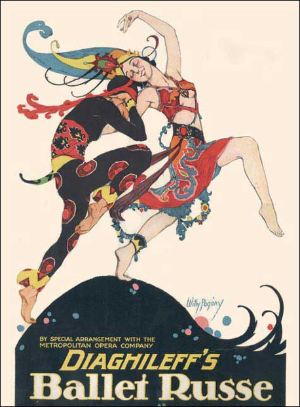
The Ballet Russe in 1909- The Winds of Change.from the Art Nouveau movement, and the arrival of the Ballet Russe – first in 1906 as an exhibition organized by founder Serge Diaghilev and then in 1909 the explosive performances of the Imperial Russian Ballet, with its exuberant eastern inspired costumes designed by Leon Bakst, that the winds of change really stirred.
Paris was by 1900 the leading fashion centre of the world and the houses of Worth, Callot Soeurs, Doucet and Paquin were the leading names. High fashion or Haute Couture was the name of the game, using the costliest fabrics and marketed to the wealthy elite of Paris, London and New York. However the style was essentially the same – the Empire line and Directoire style , with high waist and linear lines being the favored look, with pastel colors such as eau de nil, rose pink and sky blue resembling a sort of in club look to tea gowns and evening dresses.
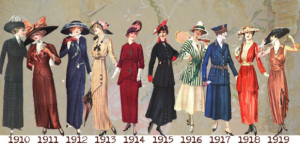
Les Modes – and Le Petit Echo de la ModeThe outbreak of The First World War in 1914 did not stop the usual Paris collections from going on display to large international attendance, but despite attempts by American Vogue’s Editor Edna Woolman Chase, to organize charitable events to aid the French fashion industry, there was understandable worry in Paris, that America was going to benefit one way or the other as competitors. If you are lucky enough to own vintage French fashion periodicals of the time like Les Modes – and Le Petit Echo de la Mode, the war is seldom mentioned.
With the notable exception of the Australians, and in particular Australian swimmer Annette Kellerman, who was 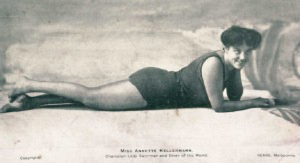
Australian swimmer Annette Kellerman, new and daring swimsuit designsomewhat of a swimsuit revolutionary, bathing costumes between 1900 and 1920 changed only gradually.
“It was an age of miracles,” F. Scott Fitzgerald wrote in his essay Echoes of the Jazz Age. “It was an age of art, it was an age of excess.” In his fiction, the author beguilingly captured the sybaritic Roaring 20s – hedonistic, glamorous, decadent, opulent. Photographs and illustrations from the era reflect this seductive, dazzling sense of wildness and fun – flapper girls smiling ecstatically and dancing with abandon in their swishing, tasseled dresses and bobbed hair, or posing in tumbling marabou boas and towering feathered head-dresses.
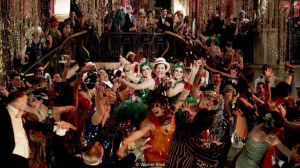
Roaring Twenties – hedonistic, glamorous, decadent, opulentThroughout 2018, we will celebrate our diverse cultural heritage across Europe – at EU, national, regional and local level. The aim of the European Year of Cultural Heritage is to encourage more people to discover and engage with Europe’s cultural heritage, and to reinforce a sense of belonging to a common European space. The slogan for the year is Our heritage: where the past meets the future. Fashion and fashion shows have become a piece of intangible heritage due to practices, representations, expressions, knowledge, skills – and the associated instruments, objects and cultural spaces – that people value.
As the effects of Brexit, a Donald Trump White House and the rise of so-called alt-right activism in Europe and North 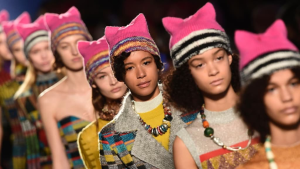
Activist fashion showAmerica ripple through the cultural waters, political dressing is trending. Protesters of all stripes — feminists, white supremacists, antifa, nationalists and social justice advocates — are outfitting themselves to match their political mindsets. This type of political dressing is not the dress code of politicians. This is individuals and groups using everyday dress to express their political outlook. The problem is that often participants and commentators, reporters and scholars, quickly rush to label it fashion.
Fashion — as it is defined — occurs when a society at large agrees to a style, aesthetic or cultural sensibility for a period of time. Fashion’s sizeable social scope and requisite expiration date is what makes it so useful as a marker of time. And fashion shows becomes a must we are all living with.
One sees it used in film, literature or social science research. Thus, fashion means timed changes in taste at a social scale. Fashion occurs in any realm of human pursuits including arts, music, technology, even scholarly discourse and of course, dress.
In today’s globalized world, most people automatically identify clothes with fashion. After all, they are one of the most visible outputs of the fashion industry. Of course, the fashion industry would do nothing to clarify this; it is in their best interest to be perceived as the source of fashion. That same fashion industry employs a global army of trend forecasters to fine-comb historical records and a multiplicity of current cultural sources and happenings. They use this data to identify what colours, styles and products people would want next season.
Fashion industry is all about making fashion statements. The industry runs on the motto to be different, stylish, edgy as well as continuous changes in every season of every year. Fashion to customers is being different from the crowd or making a statement by using clothing and accessories that set them apart. Fashion industry is getting more expensive with passing time. In the United States, around 250 billion dollars is spent on fashion and accessories like bag, shoe, etc. (Anon., 2012)
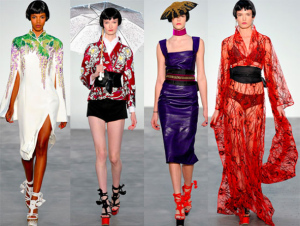
Cultural fashion showWhen fashion industry is concerned, culture is an integral part of it. Fashion and culture goes hand in hand. Our clothes are a source of non-verbal communication which send messages about who we are, where we come from, what we do and etc. Overall, fashion is a way of expressing ourselves through our clothing and accessories. People try to stay “in fashion” and they are mostly influenced by popular culture which is reflection of cultural forces as well as social factors.
Global consumerism: Widespread use of the internet and communications are changing how and on what people spend their money. This phenomenon has led to emergence of the global citizens who participate in the global marketplace through multinational corporations offering brands which meet their ever changing needs. (Byrnes, 2007, p. 1) This combination of global culture and global connectivity can be defined as globalization. Globalization has created a market with no border and as a result culture is running free in this new era. Now a day, we can see Indian food in every city of the globe or people living in Western countries are wearing ethnic clothes.
Consumption is an action that varies from culture to culture. (Byrnes, 2007, p. 2) The result of adopting consumption related values on a worldwide scale has been referred to as a ‘global consumer culture’. Global consumer culture is “shared sets of consumption-related symbols such as product categories, brands, and common consumption activities”. (Lee, 2006)
Global fashion consumerism: the global fashion industry is growing and changing at an incredible rate. According to a study in 2010, Dubai was supposed to reach $655 billion in textile and apparel trade which is 6% of global exports. The data indicates how fashion is evolving in the era of globalization. UAE was the biggest market for Swiss watches in 2013 and had increased 23% year-on-year to $835 million. (Wyne, 2013) This data shows the shift it global fashion consumerism. Meaning, now the Middle East has started emerging as the fashion hub though New York and Paris are still considered as fashion cities of the world. This change has been possible because of UAE’s vast amount of disposable income and also the influence of western culture in the people’s mind.
Cultural influence on fashion: it is important to know the influence of culture on fashion industry and to foresee cultural and social movements in order to comprehend the fashion environment. Fashion is not an isolated factor of clothing or accessories but it is connected to our life in every aspect and among them culture is the most significant. Fashion goes further than clothing and into the manner we desire to live our lives.Meaning, fashion influences our lifestyle. Fashion is influenced by cultural changes, such as modernization, art and even technological innovation.
Paris fashion week or heritage fashion. Given the economic 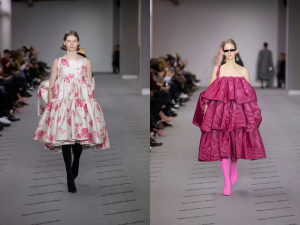
French haute couture fashion showclimate, French luxury houses’ style heritage is more than ever a major source of inspiration for their creative directors. We are witnessing a return to safe bets, which are seen as lucrative all round, marking a celebration for some and a rite of passage for others.
Nowadays, vintage dresses and apparel pieces are considered valuable heritage items. Accessories with a story behind are all about “heritage”. That is, clothes and apparel made today but with the same care in construction as their predecessors can become fashion heritage articles. More specifically, clothes with a story or something that turned a humble shirt, bag, shoe into a fashion icon are accompanying us everywhere and we can perform a permanent fashion show along our path in life.
Anca-Stefania Muntean
Bibliography
Golden Age of Style Hardcover – March 1, 1989 by Julian Robinson (Author), Paul Allier (Illustrator), George Barbier (Drawing)
Article in the Conversation, online, by Henry Navarro Delgado, Assistant Professor of Fashion, Ryerson University
Anon., 2010. Cultural influences on trend forecasting. [Online] Available at: http://www.intothefashion.com/2010/01/cultural-influences-on-trend.html [Accessed 22 February 2015].
Anon., 2012. Fashion and Consumerism. [Online] Available at: http://fashionormassconsumerism.blogspot.com/ [Accessed 21 February 2015].
Anon., n.d. BUDGET STYLE TIPS: FASHION CYCLES. [Online] Available at: http://www.bargainshopper.com.au/Fashion-cycles [Accessed 22 February 2015].
Byrnes, K., 2007. The Sharing of Culture: Global Consumerism. UW-L Journal of Undergraduate Research
Wikipedia
[1] Valerie Steele, chief curator and director of the Museum at the Fashion Institute of Technology, quoted in Fortini, Amanda. How the Runway Took Off: A Brief History of the Fashion Show. SlateMagazine (February 8, 2006).
[2] Fortini, Amanda. How the Runway Took Off: A Brief History of the Fashion Show. Slate Magazine (February 8, 2006).


 Université Jean Monnet
Université Jean Monnet